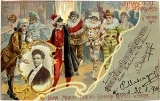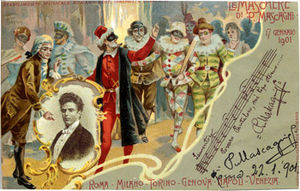
Le maschere
Encyclopedia
Le maschere is an opera
in a Prologue
and three acts by Pietro Mascagni
to an Italian
libretto
by Luigi Illica
.
The work was Mascagni's homage to Rossini and to the Italian opera buffa
and commedia dell'arte
traditions. It was premiered simultaneously in six Italian opera houses on January 17, 1901: La Scala
(with Caruso as Florindo, Carelli
as Rosaura, and Toscanini conducting); the Teatro Carlo Felice
in Genoa
; the Teatro Regio in Turin
; the Teatro Costanzi in Rome
; La Fenice
in Venice
; and the Teatro Filarmonico
in Verona
. Two days later, it premiered at the Teatro San Carlo in Naples
.
Apart from the performance in Rome, conducted by Mascagni himself, Le maschere received a dismal reception, with the performance in Genoa suspended half-way through because of the audience's vociferous expressions of displeasure. The opera was sporadically performed in Italy over the next four years and then sank into obscurity. When Mascagni revised and represented the opera in 1931 it met with little lasting success.

, Amelia Felle, Giuseppe Sabbatini
, et al.; Orchestra and Chorus of the Teatro Comunale di Bologna
). Conductor: Gianluigi Gelmetti
. Ricordi / Fonit Cetra RFCD 2004
Opera
Opera is an art form in which singers and musicians perform a dramatic work combining text and musical score, usually in a theatrical setting. Opera incorporates many of the elements of spoken theatre, such as acting, scenery, and costumes and sometimes includes dance...
in a Prologue
Prologue
A prologue is an opening to a story that establishes the setting and gives background details, often some earlier story that ties into the main one, and other miscellaneous information. The Greek prologos included the modern meaning of prologue, but was of wider significance...
and three acts by Pietro Mascagni
Pietro Mascagni
Pietro Antonio Stefano Mascagni was an Italian composer most noted for his operas. His 1890 masterpiece Cavalleria rusticana caused one of the greatest sensations in opera history and single-handedly ushered in the Verismo movement in Italian dramatic music...
to an Italian
Italian language
Italian is a Romance language spoken mainly in Europe: Italy, Switzerland, San Marino, Vatican City, by minorities in Malta, Monaco, Croatia, Slovenia, France, Libya, Eritrea, and Somalia, and by immigrant communities in the Americas and Australia...
libretto
Libretto
A libretto is the text used in an extended musical work such as an opera, operetta, masque, oratorio, cantata, or musical. The term "libretto" is also sometimes used to refer to the text of major liturgical works, such as mass, requiem, and sacred cantata, or even the story line of a...
by Luigi Illica
Luigi Illica
Luigi Illica was an Italian librettist who wrote for Giacomo Puccini , Alfredo Catalani, Umberto Giordano, Baron Alberto Franchetti and other important Italian composers. His most famous opera librettos are those for La bohème, Tosca, Madama Butterfly and Andrea Chénier.Illica was born at...
.
The work was Mascagni's homage to Rossini and to the Italian opera buffa
Opera buffa
Opera buffa is a genre of opera. It was first used as an informal description of Italian comic operas variously classified by their authors as ‘commedia in musica’, ‘commedia per musica’, ‘dramma bernesco’, ‘dramma comico’, ‘divertimento giocoso' etc...
and commedia dell'arte
Commedia dell'arte
Commedia dell'arte is a form of theatre characterized by masked "types" which began in Italy in the 16th century, and was responsible for the advent of the actress and improvised performances based on sketches or scenarios. The closest translation of the name is "comedy of craft"; it is shortened...
traditions. It was premiered simultaneously in six Italian opera houses on January 17, 1901: La Scala
La Scala
La Scala , is a world renowned opera house in Milan, Italy. The theatre was inaugurated on 3 August 1778 and was originally known as the New Royal-Ducal Theatre at La Scala...
(with Caruso as Florindo, Carelli
Emma Carelli
Emma Carelli was an Italian operatic soprano who was particularly associated with the dramatic soprano roles of the verisimo repertoire and the works of Richard Wagner....
as Rosaura, and Toscanini conducting); the Teatro Carlo Felice
Teatro Carlo Felice
The Teatro Carlo Felice is the principal opera house of Genoa, Italy, used for performances of opera, ballet, orchestral music, and recitals. It is located on the Piazza De Ferrari....
in Genoa
Genoa
Genoa |Ligurian]] Zena ; Latin and, archaically, English Genua) is a city and an important seaport in northern Italy, the capital of the Province of Genoa and of the region of Liguria....
; the Teatro Regio in Turin
Turin
Turin is a city and major business and cultural centre in northern Italy, capital of the Piedmont region, located mainly on the left bank of the Po River and surrounded by the Alpine arch. The population of the city proper is 909,193 while the population of the urban area is estimated by Eurostat...
; the Teatro Costanzi in Rome
Rome
Rome is the capital of Italy and the country's largest and most populated city and comune, with over 2.7 million residents in . The city is located in the central-western portion of the Italian Peninsula, on the Tiber River within the Lazio region of Italy.Rome's history spans two and a half...
; La Fenice
La Fenice
Teatro La Fenice is an opera house in Venice, Italy. It is one of the most famous theatres in Europe, the site of many famous operatic premieres. Its name reflects its role in permitting an opera company to "rise from the ashes" despite losing the use of two theatres...
in Venice
Venice
Venice is a city in northern Italy which is renowned for the beauty of its setting, its architecture and its artworks. It is the capital of the Veneto region...
; and the Teatro Filarmonico
Teatro Filarmonico (Verona)
The Teatro Filarmonico or Verona Philharmonic Theatre is the main opera theater in Verona, Italy, and is one of the leading Opera Houses in Europe...
in Verona
Verona
Verona ; German Bern, Dietrichsbern or Welschbern) is a city in the Veneto, northern Italy, with approx. 265,000 inhabitants and one of the seven chef-lieus of the region. It is the second largest city municipality in the region and the third of North-Eastern Italy. The metropolitan area of Verona...
. Two days later, it premiered at the Teatro San Carlo in Naples
Naples
Naples is a city in Southern Italy, situated on the country's west coast by the Gulf of Naples. Lying between two notable volcanic regions, Mount Vesuvius and the Phlegraean Fields, it is the capital of the region of Campania and of the province of Naples...
.
Apart from the performance in Rome, conducted by Mascagni himself, Le maschere received a dismal reception, with the performance in Genoa suspended half-way through because of the audience's vociferous expressions of displeasure. The opera was sporadically performed in Italy over the next four years and then sank into obscurity. When Mascagni revised and represented the opera in 1931 it met with little lasting success.
Roles

| Role | Voice type | Premiere Cast at La Fenice La Fenice Teatro La Fenice is an opera house in Venice, Italy. It is one of the most famous theatres in Europe, the site of many famous operatic premieres. Its name reflects its role in permitting an opera company to "rise from the ashes" despite losing the use of two theatres... 17 January 1901 (Conductor: - ) |
|---|---|---|
| Rosaura | soprano Soprano A soprano is a voice type with a vocal range from approximately middle C to "high A" in choral music, or to "soprano C" or higher in operatic music. In four-part chorale style harmony, the soprano takes the highest part, which usually encompasses the melody... |
Maria Farneti |
| Arlecchino Battocchio | tenor Tenor The tenor is a type of male singing voice and is the highest male voice within the modal register. The typical tenor voice lies between C3, the C one octave below middle C, to the A above middle C in choral music, and up to high C in solo work. The low extreme for tenors is roughly B2... |
E. Giordani |
| Colombina | soprano | M.a Fiori |
| Il Capitan Spaventa | baritone Baritone Baritone is a type of male singing voice that lies between the bass and tenor voices. It is the most common male voice. Originally from the Greek , meaning deep sounding, music for this voice is typically written in the range from the second F below middle C to the F above middle C Baritone (or... |
Nestore della Torre |
| Brighella | tenor | Augusto Balboni |
| Dottor Graziano | baritone | Felice Foglia |
| Pantalone De' Bisognosi | bass Bass (voice type) A bass is a type of male singing voice and possesses the lowest vocal range of all voice types. According to The New Grove Dictionary of Opera, a bass is typically classified as having a range extending from around the second E below middle C to the E above middle C... |
Ruggero Galli Ruggero Galli Ruggero Galli was an Italian operatic bass who had an active career during the late 19th century and early 20 century. He created roles in several world premieres, including Menico in Antonio Smareglia's Nozze istriane , Cesare Angelotti in Giacomo Puccini's Tosca , and Pantalone De' Bisognosi in... |
| Florindo | tenor | Elvino Ventura |
| Tartaglia | baritone | Giovanni Bellucci |
| Giocadio | spoken | Carlo Duse |
Synopsis
In the Prologue, a travelling commedia dell'arte troupe and their impressario present the characters they are about to play. The remaining three acts are the play itself wherein after many vicissitudes, Florindo and Rosaura, aided by Columbina and Arlecchino, manage to prevent the marriage which Rosaura's father, Pantalone, had planned for her.Recordings
Mascagni: Le Maschere (Maria Josè Gallego, Vincenzo La ScolaVincenzo La Scola
Vincenzo La Scola was an Italian tenor who had a successful international opera career and theatrical career for more than 25 years. He was particularly admired for his portrayals in operas by Giuseppe Verdi, Giacomo Puccini, Gaetano Donizetti, and Vincenzo Bellini...
, Amelia Felle, Giuseppe Sabbatini
Giuseppe Sabbatini
Giuseppe Sabbatini is a lyric tenor.His opera repertoire includes Idomeneo, Mitridate, re di Ponto, Don Giovanni, Linda di Chamounix, La favorita, L'elisir d'amore, Anna Bolena, Maria Stuarda, Roberto Devereux, Lucrezia Borgia, Dom Sébastien, I puritani, Rigoletto, La Traviata, Falstaff, La...
, et al.; Orchestra and Chorus of the Teatro Comunale di Bologna
Teatro Comunale di Bologna
The Teatro Comunale di Bologna is an opera house in Bologna, Italy, and is one of the most important opera venues in Italy. Typically, it presents eight operas with six performances during its November to April season....
). Conductor: Gianluigi Gelmetti
Gianluigi Gelmetti
Gianluigi Gelmetti is an Italian conductor and composer.He studied conducting with Franco Ferrara, Sergiu Celibidache and Hans Swarowsky. He first conducted an orchestra in Siena at age 16....
. Ricordi / Fonit Cetra RFCD 2004

